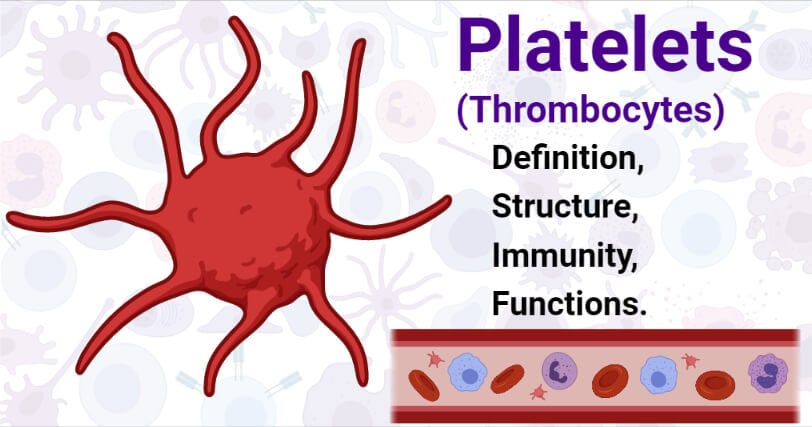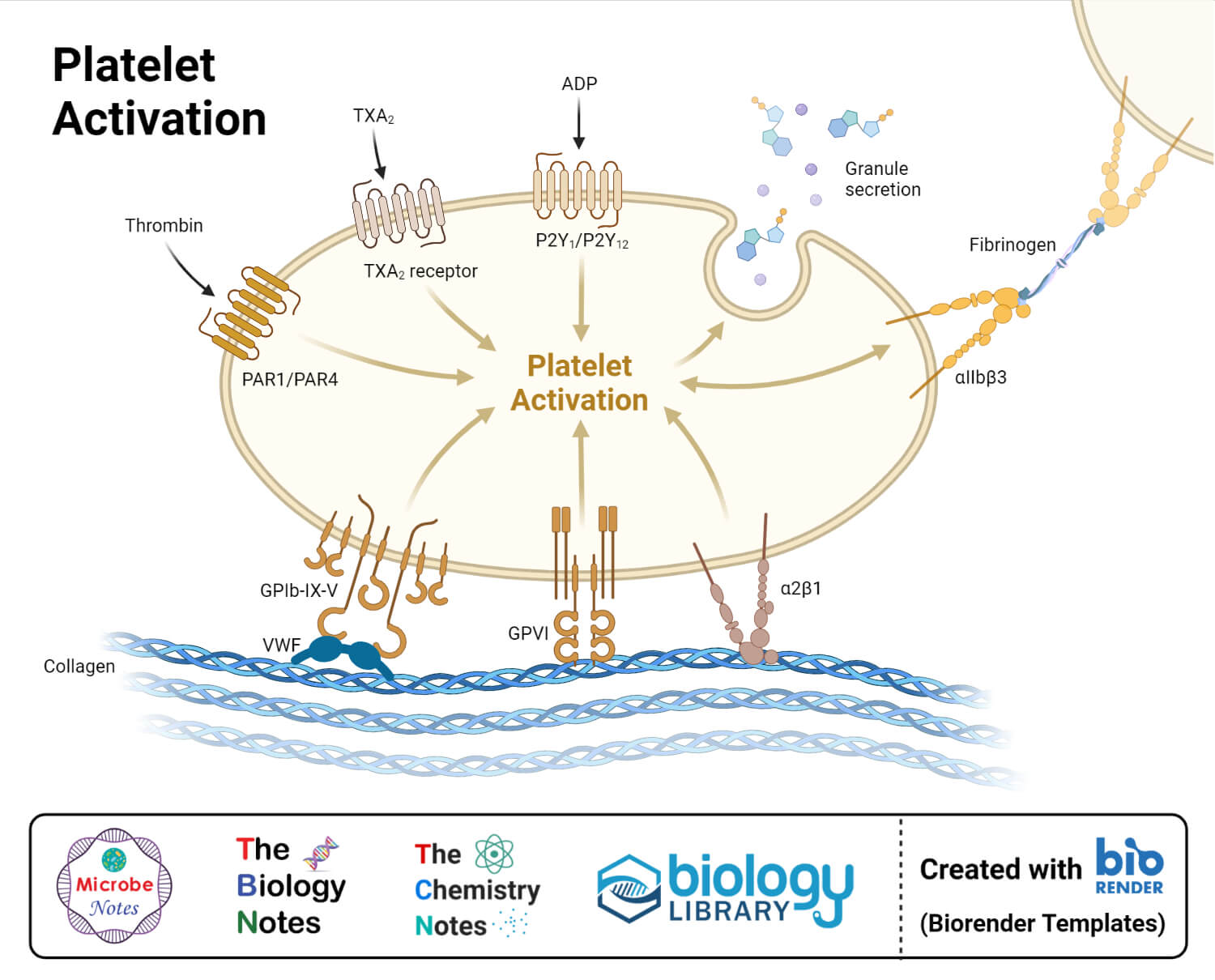Platelets or thrombocytes are anucleated cells derived from the megakaryocytic cells in the bone marrow that, besides being one of the key players in maintaining hemostasis, are involved in developing non-hemostatic immune functions.
- Platelets the second most abundant cells in the blood circulation, with the concentration ranging between 150-400 × 109 /L.
- The involvement of platelets in innate immunity is the result of their ability to release a group of inflammatory mediators as a result of activation.
- Besides, platelets can also function as effector cells by interacting with pathogens like bacteria, viruses, fungi, and protozoans.
- Some platelets secrete effector molecules that act as chemoattractants for macrophages, lymphocytes, and other immune cells.
- The most prominent function of platelets is to initiate blood coagulation, and thus, these usually remain dynamic.
- However, some platelets remain in an inactive state and get activated only in the case of damage to the blood vessels.
- Platelets also influence the adaptive immune responses as these express a wide range of immune receptors that can interact with immune cells as the vascular endothelium.
- Platelets are anucleated cells and thus do not have any nucleus, but these are rich in nucleic acids like mitochondrial DNA and RNA.
- Platelets also share other features with immune cells, like the presence of granules in the cytoplasm that release different mediators upon activation by exocytosis.

Interesting Science Videos
Structure of Platelets (Thrombocytes)
- Platelets are anucleated cells with a diameter of 1-3 µm, but the size can increase up to 6 µm after activation.
- Platelets are often considered fragments of cells instead of an actual cell as these lack many components of a normal cell.
- The outermost region of the cell contains a membrane and its invaginations, resulting in the formation of an open canalicular system.
- Underneath the membrane is a cytoplasm consisting of a distinct network of microfilaments that form an extensive cytoplasmic filament system.
- Even though platelets are anuclear, they contain cellular organelles like RNA, ribosomes, mitochondria, and granules that are essential for the function of the cell.
- Granules occurring in platelets are of three different types; α-granules, dense granules, and lysosomes.
- α-granules are the most abundant and largest granules occurring in the platelets. These contain platelet factors that are responsible for hemostasis.
- The dense granules are the smallest granules that appear as dense bodies under an electron microscope. These contain ADH, serotonin, and high levels of calcium.
- Lysosomes are also present in the cytoplasm of the platelets that contain hydrolytic enzymes like acid phosphatase and arylsulfatase.
How do Platelets work against pathogens? (Immunity)
- All platelets must undergo a series of changes in response to different stimuli. The activation of platelets causes different morphological changes in the cell.
- The cell loses its round, spherical shape and has an irregularly shaped appearance along with pseudopodia.
- The storage granules occurring in the cytoplasm fuses with the cell membrane, which triggers the release of a set of cytokines and the expression of surface molecules.
- Besides, the affinity of the adhesion molecules like GPIb-V-X complexes is upregulated during activation, leading to increased platelet adhesion and aggregation.
- The surface receptors found in platelets include receptors like TLRs, which are essential for the activation of different immune cells.
- It has also been studied that TLR4 that induces the activation of platelets is the result of increased adhesion to PMN cell. This further enhances neutrophil activation and formation of neutrophil extracellular traps, which prevents bacterial spreading.
- Platelets also express CD154 receptors that directly stimulate the endothelial cells to induce inflammation at the wall of the blood vessel.
- The other set of receptors occurring in platelets are FcγRIIA, glycoprotein VI, and C-type lectin receptor; however, the presence of these receptors depends on the individual features of the cells.
- The binding of these receptors to the fibrinogen is responsible for the activation of platelets and the release of cytoplasmic granules.
- The activation of platelets is accompanied by the release of several molecules into the bloodstream. These molecules are capable of inducing inflammation or other immune responses in the body.

Functions of Platelets (Thrombocytes)
The following are some of the functions of platelets:
- The most important function of platelets is to maintain hemostasis by aggregating with other platelets and initiating a coagulation cascade that prevents significant loss of blood.
- Platelets are among the first few cells that recognize damage in the endothelial tissue and the presence of microbial pathogens.
- Different platelets also express pattern recognition receptors like TLLR, which can detect pathogen-associated molecular patterns and help induce an effective immune response.
- During activation, platelets release a set of mediators that help in the recruitment of immune cells as well as the activation of cells of adaptive immunity.
- Degranulation of platelets results in the release of compounds that act as chemoattractants for other immune cells like macrophages, neutrophils, and dendritic cells.
- In organs like the lungs, skin, and kidneys, platelets affect leukocyte recruitment during inflammation.
References
- Peter J. Delves, Seamus J. Martin, Dennis R. Burton, and Ivan M. Roitt(2017). Roitt’s Essential Immunology, Thirteenth Edition. John Wiley & Sons, Ltd.
- Judith A. Owen, Jenni Punt, Sharon A. Stranford (2013). Kuby Immunology. Seventh Edition. W. H. Freeman and Company.
- Spencer F.A., Becker R.C. (1997) Platelets: Structure, Function, and Their Fundamental Contribution to Hemostasis and Pathologic Thrombosis. In: Becker R.C. (eds) Textbook of Coronary Thrombosis and Thrombolysis. Developments in Cardiovascular Medicine, vol 193. Springer, Boston, MA. https://doi.org/10.1007/978-0-585-33754-8_3
- Fountain JH, Lappin SL. Physiology, Platelet. [Updated 2020 Sep 18]. In: StatPearls [Internet]. Treasure Island (FL): StatPearls Publishing; 2021 Jan-. Available from: https://www.ncbi.nlm.nih.gov/books/NBK470328/
- Williams O, Sergent SR. Histology, Platelets. [Updated 2020 May 21]. In: StatPearls [Internet]. Treasure Island (FL): StatPearls Publishing; 2021 Jan-. Available from: https://www.ncbi.nlm.nih.gov/books/NBK557800/
- Ali, Ramadan A et al. “Platelets: essential components of the immune system.” Current trends in immunology vol. 16 (2015): 65-78.
- Herter JM, Rossaint J, Zarbock A. Platelets in inflammation and immunity. J Thromb Haemost. 2014 Nov;12(11):1764-75. doi: 10.1111/jth.12730. Epub 2014 Oct 13. Erratum in: J Thromb Haemost. 2015 Mar;13(3):490. PMID: 25224706.
- Trzeciak-Ryczek A, Tokarz-Deptuła B, Deptuła W. Platelets–an important element of the immune system. Pol J Vet Sci. 2013;16(2):407-13. doi: 10.2478/pjvs-2013-0058. PMID: 23971215.
- Duerschmied D, Bode C, Ahrens I. Immune functions of platelets. Thromb Haemost. 2014 Oct;112(4):678-91. doi: 10.1160/TH14-02-0146. Epub 2014 Sep 11. PMID: 25209670.
- Elzey BD, Sprague DL, Ratliff TL. The emerging role of platelets in adaptive immunity. Cell Immunol. 2005 Nov;238(1):1-9. doi: 10.1016/j.cellimm.2005.12.005. Epub 2006 Jan 26. PMID: 16442516.
- Huang HS, Chang HH. Platelets in inflammation and immune modulations: functions beyond hemostasis. Arch Immunol Ther Exp (Warsz). 2012 Dec;60(6):443-51. doi: 10.1007/s00005-012-0193-y. Epub 2012 Sep 1. PMID: 22940877.
